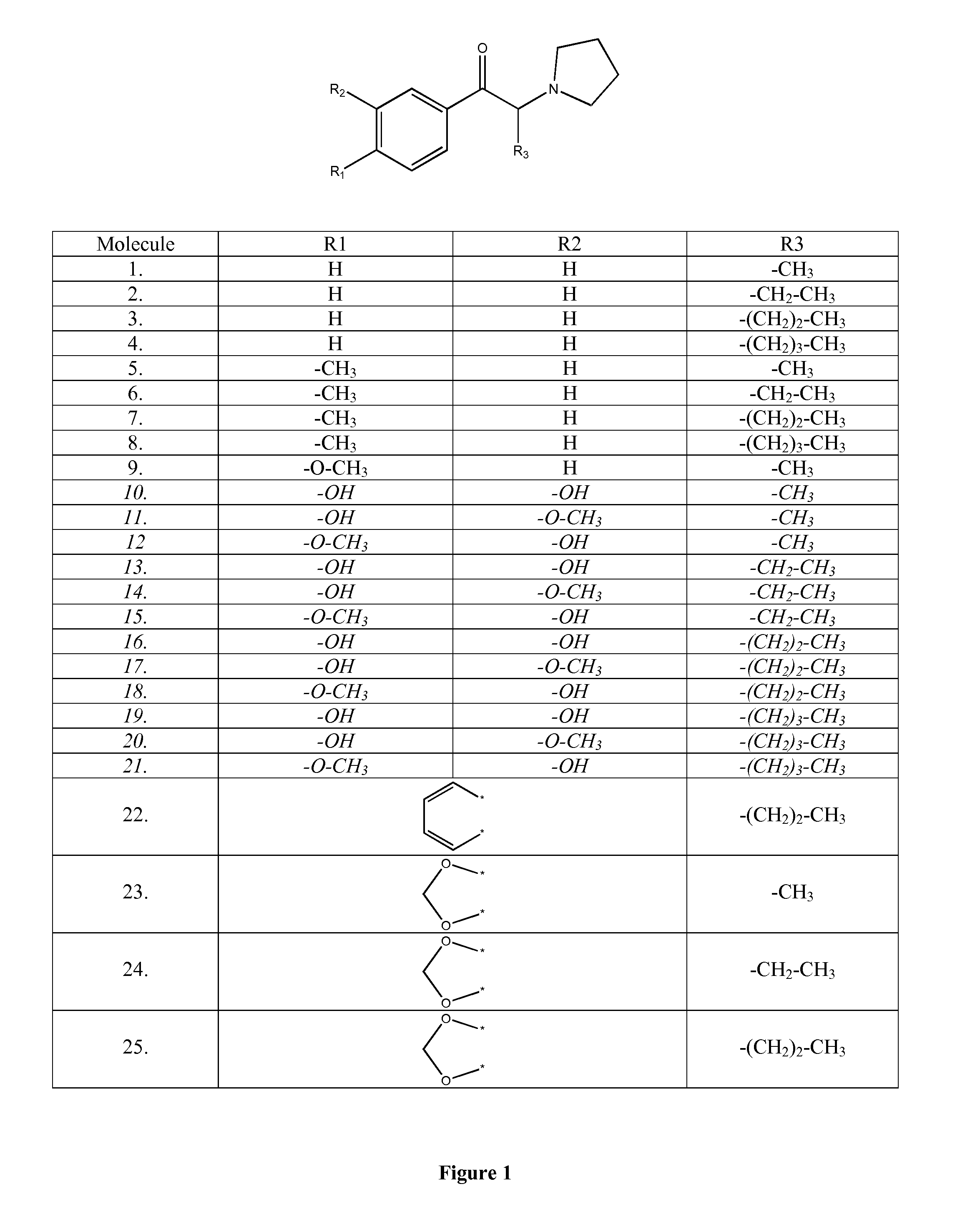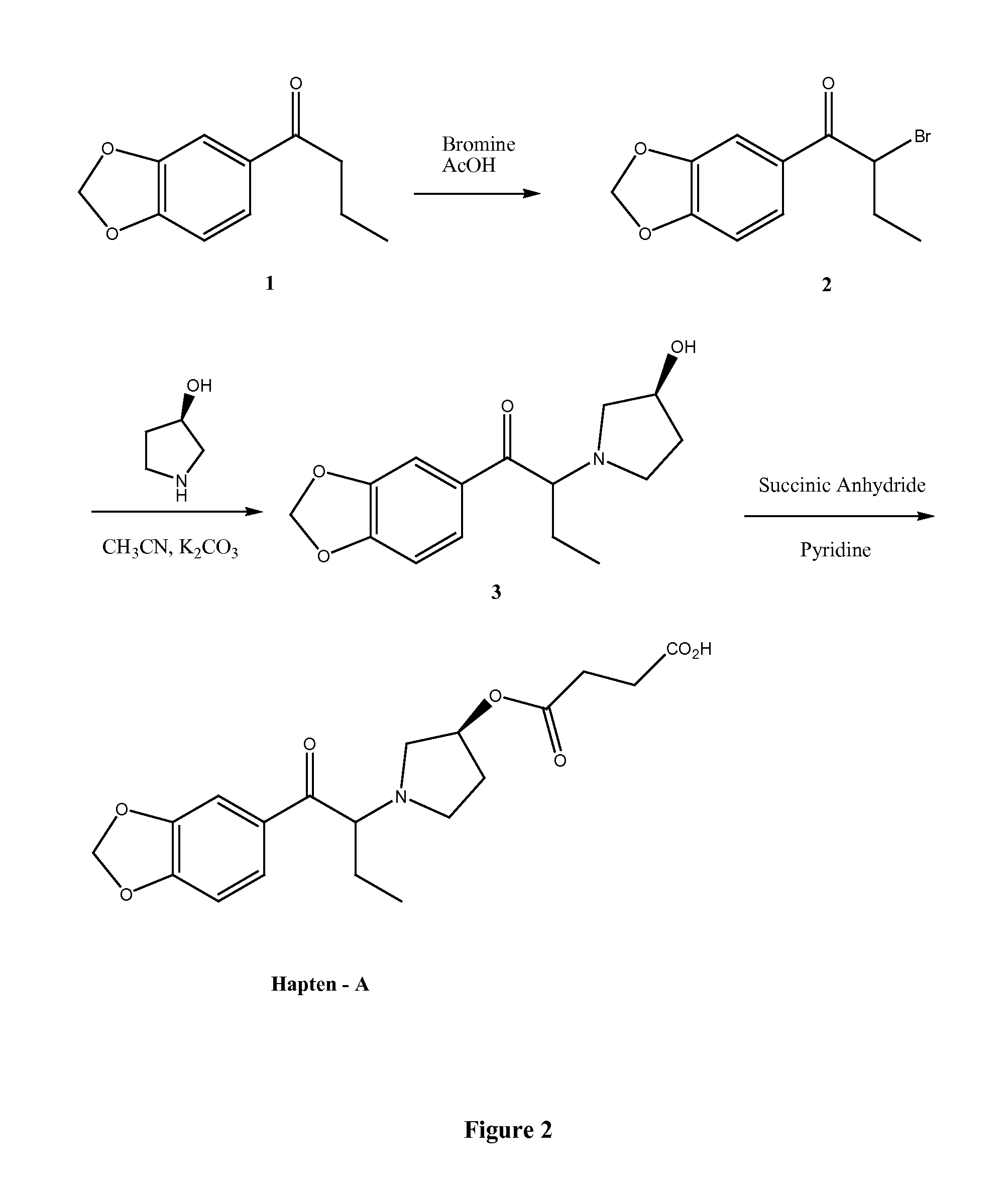Immunoassay for pyrrolidinophenones
a technology of pyrrolidinophenone and immunoassay, which is applied in the field of analytical detection of pyrrolidinophenone, can solve the problems of high cost of equipment and highly trained staff for their operation, difficulty and uncertainty in identification using established methods, and high cost of methods. , to achieve the effect of simple analytical technique, high scope and utility, and low cos
- Summary
- Abstract
- Description
- Claims
- Application Information
AI Technical Summary
Benefits of technology
Problems solved by technology
Method used
Image
Examples
example 1
Synthesis of (RS)-1-(benzo[d][1,3]dioxol-5-yl)-2-bromobutanone
[0056]To a solution of 1-(benzo[d][1,3]dioxol-5-yl)butanone (25 g, 0.13 mole) in acetic acid (100 ml) was added dropwise a solution of bromine (21.8 g, 0.137 mole) in acetic acid (100 ml). The reaction mixture was then stirred at room temperature for two hours. Acetic acid was removed under high vacuum. Water (200 ml) was added to the mixture and the solution was extracted with dichloromethane (2×200 ml). The combined organic layers were washed with saturated NaHCO3 solution (100 ml), water (100 ml) and brine (100 ml). The dichloromethane solution was dried over Na2SO4, filtered and concentrated to dryness under vacuum. The crude product obtained was purified by chromatography on silica gel using 5% ethyl acetate in hexane to give the title compound (29.6 g, 84%).
example 2
Synthesis of (RS)-1-(benzo[d][1,3]dioxol-5-yl)-2-((R)-3-hydroxypyrrolidin-1-yl)butanone
[0057]To a solution (RS)-1-(benzo[d][1,3]dioxol-5-yl)-2-bromobutanone (7.92 g, 27.8 mmol) in acetonitrile (100 ml) was added potassium carbonate (7.93 g, 57.4 mmol) and (R)-(+)-3-pyrrolidinol (5.0 g, 57.4 mmol) and the mixture stirred under nitrogen overnight at room temperature. The mixture was filtered and the solution evaporated to dryness. The crude obtained was purified by chromatography on silica gel using 50% ethyl acetate in hexane to give the title compound as a brown oil (5.5 g, 69.2%).
example 3
Synthesis of Hapten-A
[0058]To a solution of 1-(Benzo[d][1,3]dioxol-5-A-2-((R)-3-hydroxypyrrolidin-1-yl)butanone (4.5 g, 16.25 mmol) in anhydrous pyridine (100 ml) was added succinic anhydride (3.25 g, 32.5 mmol) and the mixture stirred overnight at room temperature. The pyridine was removed under high vacuum and the dark brown crude obtained purified by chromatography on silica gel using 20% methanol in chloroform to give Hapten-A (FIG. 2) as a light tan oil (5.95 g, 97.1%).
PUM
| Property | Measurement | Unit |
|---|---|---|
| pH | aaaaa | aaaaa |
| pH | aaaaa | aaaaa |
| structures | aaaaa | aaaaa |
Abstract
Description
Claims
Application Information
 Login to View More
Login to View More - R&D
- Intellectual Property
- Life Sciences
- Materials
- Tech Scout
- Unparalleled Data Quality
- Higher Quality Content
- 60% Fewer Hallucinations
Browse by: Latest US Patents, China's latest patents, Technical Efficacy Thesaurus, Application Domain, Technology Topic, Popular Technical Reports.
© 2025 PatSnap. All rights reserved.Legal|Privacy policy|Modern Slavery Act Transparency Statement|Sitemap|About US| Contact US: help@patsnap.com



